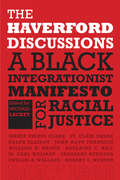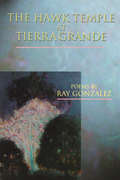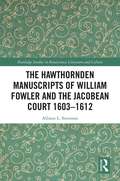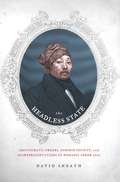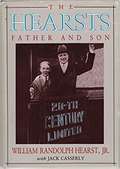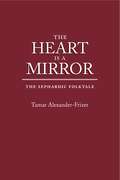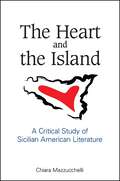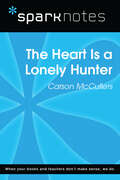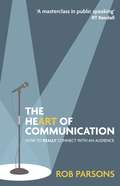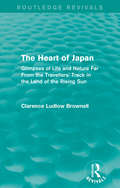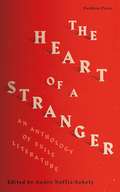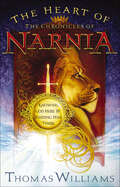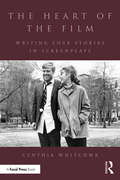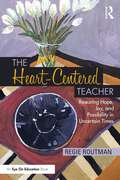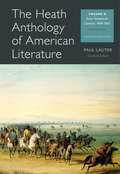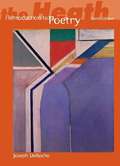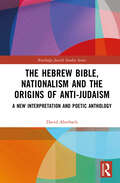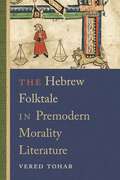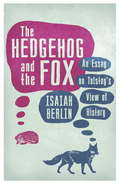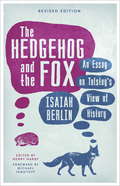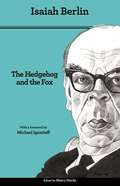- Table View
- List View
The Haverford Discussions: A Black Integrationist Manifesto for Racial Justice
by Michael LackeyIn the late sixties and early seventies, black separatist movements were sweeping across the United States. This was the era of The Autobiography of Malcolm X, Stokely Carmichael's and Charles Hamilton's Black Power, and Eldridge Cleaver's Soul on Ice. In 1969 a group of distinguished African American intellectuals met at Haverford College in order to devise strategies to dissuade young blacks from adopting a separatist political agenda. The participants included some of the most prominent figures of the civil rights era--Ralph Ellison, John Hope Franklin, and J. Saunders Redding, to name only a notable few. Although these discussions were recorded, transcribed, and edited, they were never published because the funding for them was withdrawn. This volume at last makes the historic Haverford discussions available, rescuing for the modern reader some of the most eloquent voices in the intellectual history of black America. Michael Lackey has edited and annotated the transcript of this lively exchange, and Alfred E. Prettyman has supplied an afterword. While acknowledging the importance of the black power and separatist movements, Lackey's introduction also sheds light on the insights offered by critics of those movements. Despite the frequent characterization of the dissenting integrationists as Uncle Toms or establishment intellectuals, a misrepresentation that has marginalized them in the intervening decades, Lackey argues that they had their own compelling vision for black empowerment and sociopolitical integration.
The Hawk Temple at Tierra Grande (American Poets Continuum #Vol. 72)
by Ray GonzalezKnown for his superrealism and magical images born of the imagery of the Chicano/South Western culture, Ray Gonzalez gives new imagery and intensity to the mystery and common miracles of that culture, the passionate reclamation of identity.Ray Gonzalez is a poet, essayist, and editor born in El Paso, Texas. He is the author of five books of poetry, including The Heat of Arrivals (BOA 1996), which won the 1997 Josephine Miles Book Award for Excellence in Literature, and Cabato Sentora (BOA 1999). He is the editor of twelve anthologies and serves as Poetry Editor of The Bloomsbury Review.Also available by Ray Gonzalez: The Heat of Arrivals TP $12.50, 1-880238-39-X o CUSA Cabato Sentora TP $12.50, 1-880238-70-5 o CUSA
The Hawthornden Manuscripts of William Fowler and the Jacobean Court 1603–1612 (Routledge Studies in Renaissance Literature and Culture)
by Allison L. SteensonThis book explores the unedited material contained in the Hawthornden manuscripts of William Fowler, a Scottish poet attached to the court of Queen Anna of Denmark between 1590 and 1612. The material is representative of Fowler’s ephemeral and occasional production, largely unknown to modern scholars. Through the lenses of the Hawthornden fragments, this book engages in the exploration of one of the "cultural places of the European Renaissance", represented by the extensive use of emblems and other literary devices, and by the use of manuscript copies to circulate them. The discourse mainly focuses on the Jacobean courtly establishment in the first decade of the seventeenth century, from the point of view of a Scottish insider. By focusing on the intellectual makeup of the court in the newly united Great Britain, this work aims at bridging manuscript scholarship and literary studies with a wider perspective on contemporary society, politics and culture.
The Headless State: Aristocratic Orders, Kinship Society, and Misrepresentations of Nomadic Inner Asia
by David SneathIn this groundbreaking work, social anthropologist David Sneath aggressively dispels the myths surrounding the history of steppe societies and proposes a new understanding of the nature and formation of the state. Since the colonial era, representations of Inner Asia have been dominated by images of fierce nomads organized into clans and tribes—but as Sneath reveals, these representations have no sound basis in historical fact. Rather, they are the product of nineteenth-century evolutionist social theory, which saw kinship as the organizing principle in a nonstate society.Sneath argues that aristocratic power and statelike processes of administration were the true organizers of life on the steppe. Rethinking the traditional dichotomy between state and nonstate societies, Sneath conceives of a "headless state" in which a configuration of statelike power was formed by the horizontal relations among power holders and was reproduced with or without an overarching ruler or central "head." In other words, almost all of the operations of state power existed at the local level, virtually independent of central bureaucratic authority. Sneath's research gives rise to an alternative picture of steppe life in which aristocrats determined the size, scale, and degree of centralization of political power. His history of the region shows no clear distinction between a highly centralized, stratified "state" society and an egalitarian, kin-based "tribal" society. Drawing on his extensive anthropological fieldwork in the region, Sneath persuasively challenges the legitimacy of the tribal model, which continues to distort scholarship on the history of Inner Asia.
The Hearsts: Father and Son
by William Hearst<p>From San Juan Hill to San Simeon, from Patton's tanks to the Symbionese Liberation Army, the Hearst name has been at the forefront of American life for over a century. <p>As founder of the largest U.S. prewar media empire, William Randolph Hearst, Sr., forever changed the face of American journalism by using his newspapers to aid in forcing the outbreak of the Spanish-American War. As a public figure he was larger than life, first as ambitious congressman, then as reclusive yet active businessman in the famous castle that rises above the Pacific at San Simeon. The elder Hearst was known for his extravagance as well as his long affair with Marion Davies, images that were highly embellished in Orson Welles' reproach of the Hearst persona, Citizen Kane. <p>In The Hearsts: Father and Son, William Randolph Hearst, Jr., and co-author Jack Casserly tell the extraordinary story of an American family from the gold-diggings of California to the present Hearst media empire. They also profile a cavalcade of reporters and columnists who became the stars of the Hearst newspapers, and portray the colorful New York nightlife of the 1930s and 1940s.</p>
The Heart Is a Mirror: The Sephardic Folktale
by Tamar Alexander-FrizerSince their expulsion from Spain in 1492, Sephardic Jews have managed to maintain their Jewish faith and Spanish group identity and have developed a uniquely Judeo-Spanish culture wherever they settled. Among the important cultural ties within these Sephardic groups are Judeo-Spanish folktales, stories that have been passed down from generation to generation, either in the distinct language of the group, Judeo-Spanish (Ladino), or in other languages, such as Hebrew. In The Heart Is a Mirror, Tamar Alexander-Frizer examines the folk narratives of Sephardic Jews to view them both in relation to universal narrative traditions and the traditions of Jewish culture. In part 1, Alexander-Frizer investigates the relationship between folk literature and group identity via the stories' connection to Hebrew canonical sources, their historical connection to the land of origin, their treatment of prominent family members and historical events, and their connection to the surrounding culture in the lands of the Spanish Diaspora. Part 2 contains an analysis of several important genres and subgenres present in the folktales, including legends, ethical tales, fairy tales, novellas, and humorous tales. Finally, in part 3, Alexander-Frizer discusses the art of storytelling, introducing the theatrical and rhetorical aspects tied up in the Sephardic folktales, such as the storyteller, the audience, and the circumstances of time and place. This thorough and thought-provoking study is based on a corpus of over four thousand stories told by descendents of the Spanish Diaspora. An introduction addresses methodological problems that arise from the need to define the stories as Judeo-Spanish in character, as well as from methods used to record and anthologize them. Jewish studies scholars, as well as those interested in folktale studies, will gain much from this fascinating and readable volume.
The Heart and the Island: A Critical Study of Sicilian American Literature (SUNY series in Italian/American Culture)
by Chiara MazzucchelliIn The Heart and the Island, Chiara Mazzucchelli explores the strong bond between Sicilian American writers and the island of Sicily. Self-contained yet connected to the mainland, geographically separated from yet politically united to the rest of Italy, Sicily occupies a unique position. Throughout the twentieth century, the sense of a distinct sicilianità—or Sicilianness—has manifested itself in a corpus of texts that, although subsumed under the broader context of Italian literature, have distinguished themselves as examples of an exquisitely Sicilian literary experience. Mazzucchelli argues that a parallel phenomenon—sicilianamericanità—has emerged in the United States. Focusing on the island's geography, history, and culture, she examines how many American authors of Sicilian descent derive inspiration from their ethnic milieu and lay out a recognizable set of Sicilian culture markers in their works, thereby producing a literature that is distinctly Sicilian American. Drawing on both Italian and Italian American scholarship, The Heart and the Island is the first full-length study of Sicilian American literature, and it opens a space for new interdisciplinary discussions on what it means to be Italian on both sides of the ocean.
The Heart is a Lonely Hunter (SparkNotes Literature Guide Series)
by SparkNotesThe Heart is a Lonely Hunter (SparkNotes Literature Guide) by Carson McCullers Making the reading experience fun! Created by Harvard students for students everywhere, SparkNotes is a new breed of study guide: smarter, better, faster.Geared to what today's students need to know, SparkNotes provides:chapter-by-chapter analysis explanations of key themes, motifs, and symbols a review quiz and essay topics Lively and accessible, these guides are perfect for late-night studying and writing papers.
The Heart of Boswell
by James BoswellThis volume is a distillation of the first six volumes of "The Yale Editions of the Private Papers of James Boswell", which are in turn derived from discoveries and purchases of Boswell's papers at intervals between the year of his death, 1795, and the middle years of the present century. Boswell's journal not only survives but flourishes, providing him with existence unfolding far beyond his grave. Trepidation about his death, and questions of afterlife, occupy many pages of his writing, many hours of his reflection, and a position central in his conversation and his dreams.
The Heart of Communication: How to really connect with an audience
by Rob ParsonsThe ability to connect with an audience is an essential element of public speaking. While an effective presentation can have all the elements of good pace, pitch and body language, it can still leave an audience unaffected or unmoved. Rob Parson believes even the most proficient speakers can enhance their public speaking by focusing on the heart of communication: connection.For the first time, Rob Parsons shares his insights from over fifty years of experience. He unpacks methods that will help any public speaker - from how to prepare well and utilise the power of story, to giving top tips on avoiding common distractions. Readers will come away with a better grasp on public speaking - not only how to speak to the head, but to the heart.Having spoken to over a million people around the world, from multinational organisations to church congregations, Rob has fine-tuned approaches that can help anyone wanting to grow in this area.
The Heart of Japan: Glimpses of Life and Nature Far From the Travellers' Track in the Land of the Rising Sun (Routledge Revivals)
by Brownell Clarence LudlowThis collection of commentaries and reflections on Japanese culture, first published in 1904, was written shortly after the return of two English aristocrats from five years spent immersed in the ‘Land of the Rising Sun’. Their intention through these anecdotes – some humorous and charming, others tragic and thought-provoking – was to offer glimpses into the "real inner spirit of the native life," and to provide insights into the remarkable idiosyncrasies of Japanese society during a period of unprecedented change. Touching on such diverse topics as sport, religion, music, censorship, drama and bathing, The Heart of Japan will be of particular interest to students of Japanese, as well as to those intrigued by cultural difference and exchange.
The Heart of a Stranger: An Anthology of Exile Literature
by André Naffis-SahelyA fascinatingly diverse anthology of the literature of exile, from the myths of Ancient Egypt to contemporary poetryExile lies at the root of our earliest stories. Charting varied experiences of people forced to leave their homes from the ancient world to the present day, The Heart of a Stranger is an anthology of poetry, fiction and non-fiction that journeys through six continents, with over a hundred contributors drawn from twenty-four languages. Highlights include the wisdom of the 5th century Desert Fathers and Mothers, the Swahili Song of Liyongo, The Flight of the Irish Earls, Emma Goldman's travails in the wake of the First Red Scare, the Syrian poet Nizar Qabbani's ode to the lost world of Andalusia and the work of contemporary Eritrean fabulist Ribka Sibhatu.Edited by poet and translator André Naffis-Sahely, The Heart of a Stranger offers a uniquely varied look at a theme both ancient and urgently contemporary.
The Heart of the Chronicles of Narnia: Knowing God Here by Finding Him There
by Thomas WilliamsIn addition to being one of the best-loved books of all time, The Lion, the Witch and the Wardrobe is sure to set box-office records when it releases in theatres Christmas 2005. Distributed by Disney, directed by Andrew Adamson (director of Shrek), with special effects by the WETA Workshop (The Lord of the Rings), and backed by a $150 million dollar budget, The Lion, the Witch and the Wardrobe will draw millions of eager viewers, Christian and non-Christian alike. After viewing the movie, Christians and Lewis fans will excitedly walk away with a renewed enthusiasm for this classic installment of The Chronicles of Narnia.Using exciting biblical parallels, this companion book will lead readers into a deeper understanding of Christ and will help them discover how these tales by C. S. Lewis beautifully expose a dynamic, joyful, loving God who wants his creatures to experience deep joy and delight.
The Heart of the Film: Writing Love Stories in Screenplays
by Cynthia WhitcombMost movies include a love story, whether it is the central story or a subplot, and knowing how to write a believable relationship is essential to any writer's skill set. Discover the rules and laws of nature at play in a compelling love story and learn and master them. Broken into four sections, The Heart of the Film identifies the critical features of love story development, and explores every variation of this structure as well as a diverse array of relationships and types of love. Author Cynthia Whitcomb has sold over 70 feature-length screenplays and shares the keys to her success in The Heart of the Film, drawing on classic and modern films as well as her own extensive experience.
The Heart-Centered Teacher: Restoring Hope, Joy, and Possibility in Uncertain Times
by Regie Routman"I will speak to you of what I’ve learned and what I’m still struggling with, professionally and personally, not just as a teacher and colleague but also as a wife, daughter, mother, grandmother, friend, and concerned citizen. I want to lift you up—to nourish your heart, mind, and spirit." --Regie Routman How do we find hope and possibility in challenging times? How do we bring our truest selves into our teaching and personal lives? In this unique, inspiring book, beloved author Regie Routman artfully blends stories and strategies to show how we can introduce more joy and gratitude in our classrooms and in our lives. Regie invites us to focus on what matters most in our work and in our relationships with those we hold dear. She shares ideas and practical takeaways for teaching, learning, and living: Seeing and celebrating each learner’s gifts and strengths Creating a storytelling culture Ensuring equitable opportunities for all Co-creating welcoming spaces and routines Developing professional knowledge Championing the reading-writing connection Fostering resilience and hope Taking care of ourselves and our students Making a worthy difference. "Here’s what I know for sure," writes Regie. "Living a good life is about developing, nurturing, and sustaining caring relationships—in our teaching lives, our home lives, and in the happy intersection of both." Wherever you are on your journey, no matter what loss or hardship you may face, The Heart-Centered Teacher will offer you a refreshing chance to pause, take a breath, and reflect on how you and your students can live more compassionate, generous, and authentic lives.
The Heath Anthology of American Literature: Early Nineteenth Century, 1800-1865
by Cengage StaffUnrivaled diversity and ease of use have made The Heath Anthology of American Literature: Volume B: Early Nineteenth Century, 1800-1865, 7th Edition, a best-selling text since 1989, when the first edition was published. In presenting a more inclusive canon of American literature, the seventh edition of Volume B continues to balance the traditional, leading names in American literature with lesser-known writers. Available in five volumes for greater flexibility, the 7th Edition offers thematic groupings, called In Focus, to stimulate classroom discussions and showcase the treatment of important topics across the genres.
The Heath Introduction to Poetry (Sixth edition)
by Joseph DerocheThis chronologically arranged anthology features more than 500 poems written between the eighth century and the present.
The Hebrew Bible, Nationalism and the Origins of Anti-Judaism: A New Interpretation and Poetic Anthology (Routledge Jewish Studies Series)
by David AberbachIn the attempts to unify divided peoples on the basis of a shared past, both historical and mythical, this book illumines aspects of cultural nationalism common since the Middle Ages. As an edited work, the Bible includes texts mostly depicting long-gone historical eras extending over several centuries. Following on from Aberbach’s previous work National Poetry, Empires, and War, this book argues that works of this nature – notably the Mujo-Halil songs in Albania, the Irish stories of Cuchulain, the songs of the Nibelungen in Germany, or the Finnish legends collected in The Kalevala – have an ancient precedent in the Hebrew Bible (to which national literatures often allude and refer), a subject largely neglected in biblical studies. The self-critical element in the Hebrew Bible, common in later national literature, is examined as the basis of later anti-Semitism, as the Bible was not confined to Jews but was adopted in translation by many other national groups. With several dozen original translations from the Hebrew, this book highlights how the Bible influenced and was distorted by later national cultures. Written without jargon, this book is intended for the general reader, but is also an important contribution to the study of the Bible, nationalism, and Jewish history.
The Hebrew Folktale in Premodern Morality Literature (Raphael Patai Series in Jewish Folklore and Anthropology)
by Vered ToharThis pioneering exploration shows that in the early modern world, printed works on morality and ethics served as an important conveyor of classic Jewish folktales and as an important channel of leisure reading in premodern Jewish culture. Utilizing a corpus of over 400 Musar tales, author Vered Tohar carefully opens a path to understand the thematic and poetic features of those tales. This innovative reframing of early modern Musar texts reveals a new history of Jewish folklore and emphasizes the continuity of Hebrew literature from medieval to modern era. Tohar classifies these stories, which she calls "the Musar folktales," into four genres adapted from classic poetic studies: tragedy, comedy, parable or social exemplum, and theological allegory. As parables of vice and virtue, the works featured here were originally printed and circulated in early modern Jewish communities, and each contained themes of love and hate, good and evil, loyalty and betrayal, or life and death. Beyond their traditional function of ethical and moral edification, Tohar advances the Musar texts as an archive of Hebrew tales and their ideological traditions. This innovative reframing of early modern Musar texts reveals a new history of Jewish folklore and a new way to read those texts.
The Hedgehog And The Fox: An Essay on Tolstoy's View of History
by Isaiah BerlinIsaiah Berlin's classic essay on Tolstoy - an exciting new edition with new criticism and a foreword.'The fox knows many things, but the hedgehog knows one big thing.' This fragment of Archilochus, which gives this book its title, describes the central thesis of Isaiah Berlin's masterly essay on Tolstoy. There have been various interpretations of Archilochus' fragment; Isaiah Berlin has simply used it, without implying anything about the true meaning of the words, to outline a fundamental distinction that exists in mankind, between those who are fascinated by the infinite variety of things (foxes) and those who relate everything to a central all-embracing system (hedgehogs). When applied to Tolstoy, the image illuminates a paradox of his philosophy of history, and shows why he was frequently misunderstood by his contemporaries and critics. Tolstoy was by nature a fox, but he believed in being a hedgehog.
The Hedgehog And The Fox: An Essay on Tolstoy's View of History
by Isaiah BerlinIsaiah Berlin's classic essay on Tolstoy - an exciting new edition with new criticism and a foreword.'The fox knows many things, but the hedgehog knows one big thing.' This fragment of Archilochus, which gives this book its title, describes the central thesis of Isaiah Berlin's masterly essay on Tolstoy. There have been various interpretations of Archilochus' fragment; Isaiah Berlin has simply used it, without implying anything about the true meaning of the words, to outline a fundamental distinction that exists in mankind, between those who are fascinated by the infinite variety of things (foxes) and those who relate everything to a central all-embracing system (hedgehogs). When applied to Tolstoy, the image illuminates a paradox of his philosophy of history, and shows why he was frequently misunderstood by his contemporaries and critics. Tolstoy was by nature a fox, but he believed in being a hedgehog.
The Hedgehog And The Fox: An Essay on Tolstoy's View of History (W&N Essentials)
by Isaiah BerlinIsaiah Berlin's classic essay on Tolstoy - an exciting new edition with new criticism and a foreword.'The fox knows many things, but the hedgehog knows one big thing.' This fragment of Archilochus, which gives this book its title, describes the central thesis of Isaiah Berlin's masterly essay on Tolstoy. There have been various interpretations of Archilochus' fragment; Isaiah Berlin has simply used it, without implying anything about the true meaning of the words, to outline a fundamental distinction that exists in mankind, between those who are fascinated by the infinite variety of things (foxes) and those who relate everything to a central all-embracing system (hedgehogs). When applied to Tolstoy, the image illuminates a paradox of his philosophy of history, and shows why he was frequently misunderstood by his contemporaries and critics. Tolstoy was by nature a fox, but he believed in being a hedgehog.
The Hedgehog And The Fox: An Essay on Tolstoy's View of History (W&N Essentials)
by Isaiah BerlinIsaiah Berlin's classic essay on Tolstoy - an exciting new edition with new criticism and a foreword.'The fox knows many things, but the hedgehog knows one big thing.' This fragment of Archilochus, which gives this book its title, describes the central thesis of Isaiah Berlin's masterly essay on Tolstoy. There have been various interpretations of Archilochus' fragment; Isaiah Berlin has simply used it, without implying anything about the true meaning of the words, to outline a fundamental distinction that exists in mankind, between those who are fascinated by the infinite variety of things (foxes) and those who relate everything to a central all-embracing system (hedgehogs). When applied to Tolstoy, the image illuminates a paradox of his philosophy of history, and shows why he was frequently misunderstood by his contemporaries and critics. Tolstoy was by nature a fox, but he believed in being a hedgehog.
The Hedgehog and the Fox: An Essay on Tolstoy's View of History - Second Edition
by Isaiah Berlin"The fox knows many things, but the hedgehog knows one big thing." This ancient Greek aphorism, preserved in a fragment from the poet Archilochus, describes the central thesis of Isaiah Berlin's masterly essay on Leo Tolstoy and the philosophy of history, the subject of the epilogue to War and Peace. Although there have been many interpretations of the adage, Berlin uses it to mark a fundamental distinction between human beings who are fascinated by the infinite variety of things and those who relate everything to a central, all-embracing system. Applied to Tolstoy, the saying illuminates a paradox that helps explain his philosophy of history: Tolstoy was a fox, but believed in being a hedgehog. One of Berlin's most celebrated works, this extraordinary essay offers profound insights about Tolstoy, historical understanding, and human psychology.This new edition features a revised text that supplants all previous versions, English translations of the many passages in foreign languages, a new foreword in which Berlin biographer Michael Ignatieff explains the enduring appeal of Berlin's essay, and a new appendix that provides rich context, including excerpts from reviews and Berlin's letters, as well as a startling new interpretation of Archilochus's epigram.
The Heirs of Anthony Boucher: A History of Mystery Fandom
by Marvin LachmanThe ultimate collection for mystery fansFollowing in the footsteps of those devoted to science fiction and works about Sherlock Holmes, general mystery fandom emerged in 1967 and has since thrived and become an international phenomenon. With its irresistible combination of puzzle-solving and the examination of the dark underbelly of humanity, crime fiction continues to fascinate and delight millions of readers. Ranging the gamut from cozy mysteries to fast-paced thrillers, crime fiction contains a nearly endless range of books… and, of course, a similarly diverse group of readers who devour them.Out of this rabid readership, countless websites, nearly one hundred fan magazines, and dozens of conferences celebrating mysteries have arisen to bring authors, readers, and fans together. This revised and updated edition of The Heirs of Anthony Boucher is an illuminating look at the history of mystery fandom and its effect on readers across the globe. Complete with anecdotes, personal reminiscences, facts, and pictures, it tells the story of the mystery community's publications and conventions, the fans who produce them, and the future of mystery fandom in years to come.
